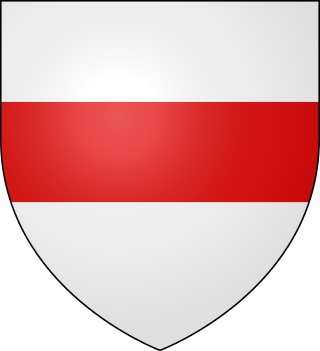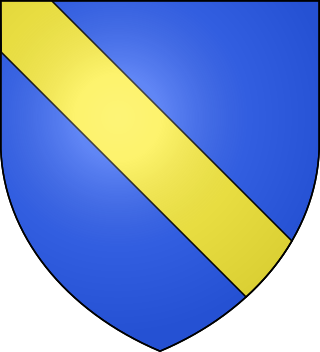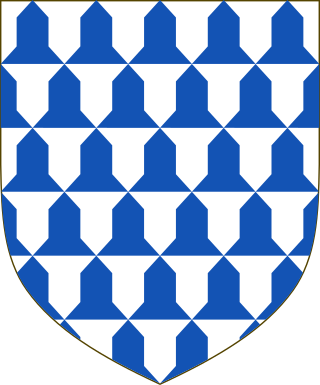
Heraldry is a discipline relating to the design, display and study of armorial bearings, as well as related disciplines, such as vexillology, together with the study of ceremony, rank and pedigree. Armory, the best-known branch of heraldry, concerns the design and transmission of the heraldic achievement. The achievement, or armorial bearings usually includes a coat of arms on a shield, helmet and crest, together with any accompanying devices, such as supporters, badges, heraldic banners and mottoes.
In heraldry, tenné is a "stain", or non-standard tincture, of orange, light brown or orange-tawny colour.

Esquire is usually a courtesy title.

Tincture is the limited palette of colours and patterns used in heraldry. The need to define, depict, and correctly blazon the various tinctures is one of the most important aspects of heraldic art and design.

In heraldry, the field (background) of a shield can be divided into more than one area, or subdivision, of different tinctures, usually following the lines of one of the ordinaries and carrying its name. Shields may be divided this way for differencing or for purposes of marshalling, or simply for style. The lines that divide a shield may not always be straight, and there is a system of terminology for describing patterned lines, which is also shared with the heraldic ordinaries.

In heraldry, variations of the field are any of a number of ways that a field may be covered with a pattern, rather than a flat tincture or a simple division of the field.

In heraldry, a fess or fesse is a charge on a coat of arms that takes the form of a band running horizontally across the centre of the shield. Writers disagree in how much of the shield's surface is to be covered by a fess or other ordinary, ranging from one-fifth to one-third. The Oxford Guide to Heraldry states that earlier writers including Leigh, Holme, and Guillim favour one-third, while later writers such as Edmondson favour one-fifth "on the grounds that a bend, pale, or chevron occupying one-third of the field makes the coat look clumsy and disagreeable." A fess is likely to be shown narrower if it is uncharged, that is, if it does not have other charges placed on it, and/or if it is to be shown with charges above and below it; and shown wider if charged. The fess or bar, termed fasce in French heraldry, should not be confused with fasces.

In heraldry, an ordinary is one of the two main types of charges, beside the mobile charges. An ordinary is a simple geometrical figure, bounded by straight lines and running from side to side or top to bottom of the shield. There are also some geometric charges known as subordinaries, which have been given lesser status by some heraldic writers, though most have been in use as long as the traditional ordinaries. Diminutives of ordinaries and some subordinaries are charges of the same shape, though thinner. Most of the ordinaries are theoretically said to occupy one-third of the shield; but this is rarely observed in practice, except when the ordinary is the only charge.

In heraldry, a bend is a band or strap running from the upper dexter corner of the shield to the lower sinister. Authorities differ as to how much of the field it should cover, ranging from one-fifth up to one-third. The supposed rule that a bend should occupy a maximum of one-third of the field appears to exclude the possibility of three bends being shown together, but contrary examples exist.

In heraldry, an escutcheon is a shield that forms the main or focal element in an achievement of arms. The word can be used in two related senses. In the first sense, an escutcheon is the shield upon which a coat of arms is displayed. In the second sense, an escutcheon can itself be a charge within a coat of arms.

In heraldry, a charge is any emblem or device occupying the field of an escutcheon (shield). That may be a geometric design or a symbolic representation of a person, animal, plant, object, building, or other device. In French blazon, the ordinaries are called pièces, and other charges are called meubles.
In British heraldry, sable is the tincture equivalent to black. It is one of the five dark tinctures called colours.

Vair, originating as a processed form of squirrel fur, gave its name to a set of different patterns used in heraldry. Heraldic vair represents a kind of fur common in the Middle Ages, made from pieces of the greyish-blue backs of squirrels sewn together with pieces of the animals' white underbellies. Vair is the second-most common fur in heraldry, after ermine.

Seax is an Old English word for "knife". In modern archaeology, the term seax is used specifically for a type of small sword, knife or dagger typical of the Germanic peoples of the Migration Period and the Early Middle Ages, especially the Saxons, whose name derives from the weapon. These vary considerably in size.

Ermine in heraldry is a "fur", a type of tincture, consisting of a white background with a pattern of black shapes representing the winter coat of the stoat. The linings of medieval coronation cloaks and some other garments, usually reserved for use by high-ranking peers and royalty, were made by sewing many ermine furs together to produce a luxurious white fur with patterns of hanging black-tipped tails. Due largely to the association of the ermine fur with the linings of coronation cloaks, crowns and peerage caps, the heraldic tincture of ermine was usually reserved to similar applications in heraldry. In heraldry it has become especially associated with the Duchy of Brittany and Breton heraldry.

In heraldry and heraldic vexillology, a blazon is a formal description of a coat of arms, flag or similar emblem, from which the reader can reconstruct the appropriate image. The verb to blazon means to create such a description. The visual depiction of a coat of arms or flag has traditionally had considerable latitude in design, but a verbal blazon specifies the essentially distinctive elements. A coat of arms or flag is therefore primarily defined not by a picture but rather by the wording of its blazon. Blazon is also the specialized language in which a blazon is written, and, as a verb, the act of writing such a description. Blazonry is the art, craft or practice of creating a blazon. The language employed in blazonry has its own vocabulary, grammar and syntax, which becomes essential for comprehension when blazoning a complex coat of arms.

In heraldry and vexillology, a heraldic flag is a flag containing coats of arms, heraldic badges, or other devices used for personal identification.

The heads of humans and other animals are frequently occurring charges in heraldry. The blazon, or heraldic description, usually states whether an animal's head is couped, erased, or cabossed. Human heads are often described in much greater detail, though some of these are identified by name with little or no further description.

A roundel is a circular charge in heraldry. Roundels are among the oldest charges used in coats of arms, dating from the start of the age of heraldry in Europe, circa 1200–1215. Roundels are typically a solid colour but may be charged with an item or be any of the furs used in heraldry. Roundels are similar to the annulet, which some heralds would refer to as a false roundel.

The coat of arms of Bellingwedde is an official symbol of the municipality of Bellingwedde in the province of Groningen in the Netherlands. It was officially adopted in 1969. The coat of arms consists of a crowned shield with blue, gold, and silver elements, which refer to the abbey Palmar and the Wedderborg.














